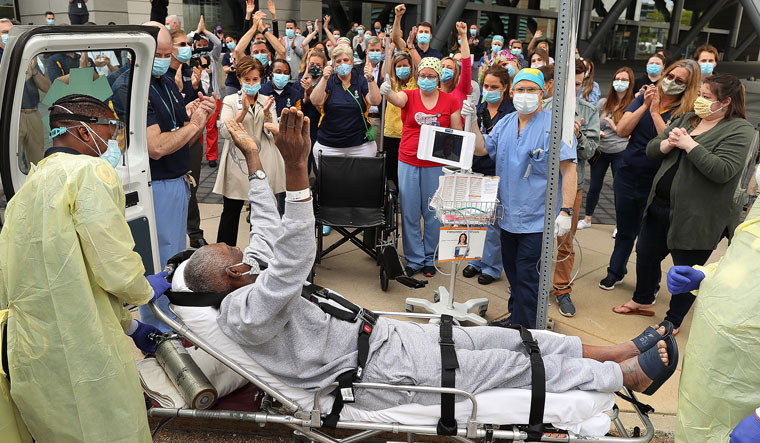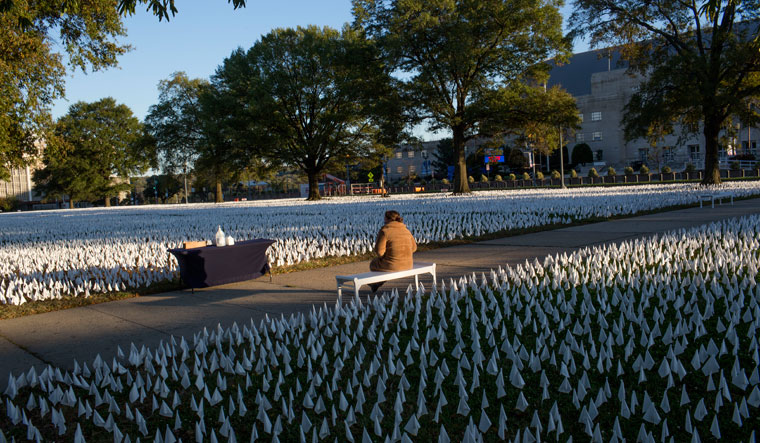It was around 5pm on March 17, 2020. The nursing administrator was on the other side of the phone: “Dr Abraham, we may have a patient in the clinic with possible exposure to Covid-19.” I was impressed by the calmness in her voice. Not yet spring, it was still cold outside and snow was melting on the ground.
The first case of Covid-19 was reported in the US on January 20 in Washington State, from a man who had been to China. The first case in New York was reported on March 1 from a person who had been to Europe. Ohio (where I work and live) had its first cases only eight days prior to it, in a couple who had been on a Nile River cruise.
When the first case of Covid-19 was reported from Wuhan in December 2019, I was curious. I had started training in the US in 1994, when the world was learning more about the AIDS epidemic. When Wuhan started getting overwhelmed by the novel coronavirus (SARS-CoV-2), all of us knew it could be bad. When I began getting emails and tweets from friends in Italy, the anxiety grew. On January 31, Italy banned all flights from China and went into lockdown on March 8.
On March 17, even though most of the patients were done for the day, our cancer centre’s third floor clinic area was buzzing with activity. I could see anxious family members in winter jackets pacing the hallway.
My oncology colleague, who had been taking care of the patient with potential Covid-19 exposure, was waiting for me. His glasses were fogged through his mask and I could not see his eyes.
“This is a 58-year-old gentleman who was seen for low-grade fever, cough and shortness of breath. After completing the examination, I was going to get an X-ray and start him on antibiotics for possible pneumonia,” explained my colleague, pausing for a second to get more breath through the mask. “Then the patient told me that his son had just come back from Italy and was staying with him. He thinks his son is fine, but he knows that he has been coughing for a few days.”
We reviewed the patient’s CAT scan, and it showed diffuse infiltrative pattern, which could be a classical finding of SARS-CoV-2 pneumonia, or it could be due to lung cancer, other forms of pneumonia, or immunotherapy. His fever, cough and shortness of breath could be symptoms of Covid-19, as per the guidelines issued then from the World Health Organization and Centers for Disease Control and Prevention.
We did not want to take any chances. Our priority was very clear: We need to take care of the patient and protect our caregivers from potential exposure. The patient was already in a private room with a mask. All the caregivers were wearing protective gear.
I called our organisation’s chief of infectious disease. With the information we knew about Covid-19 at that time, he said the chance of the patient and the provider getting infected is unknown. And we needed to take all precautions.
The nursing team had many questions about the virus, risk of exposure and other potential risks. I was able to tell them only what I had learnt from the chief of infectious disease. I told them that I would update them when I found out more about the disease. But the whole world was still learning about Covid-19, and at that point we did not know anything about the impact of Covid-19 exposure on cancer patients who were on immunosuppressive therapy.
ICUs and ventilators in Italy were getting filled and pictures of patients dying were playing on my mind.
With our hospital system already running at full capacity and with the cleaning and isolation protocols, it took some time for us to get the patient to the isolation room. Our oncology leadership team stayed with the patient’s care team until we were sure that the patient’s care was transferred to the inpatient team.
By the second week of March, Cleveland Clinic, with its vast clinical network of hospitals in Ohio, Florida, Nevada, Canada, Abu Dhabi and London, was gearing up for the pandemic. Our CEO had called a staff meeting a few days prior, and started the process to prepare for the unknown. He established a command centre, rolled out a communication plan and assembled a team of experts from patient safety, infectious disease, pathology, nursing, operations and communications.
None of us knew how this would impact the next several months. None of us knew that we were getting ready for the worst pandemic of our lifetime. None of us knew that more than two lakh Americans and about 1.2 million people across the world would die from this infection. We did not know that the economy of many countries would be destroyed. That the poor, older people, especially people of colour (in the US) would pay the highest price.
In the past eight months, my learning curve as the leader of one of the largest cancer departments in the US, in one of the best hospitals in the world, has been pretty steep. I have been humbled and inspired, especially by the kindness and compassion of my colleagues and leaders around me.
In ensuing months, Cleveland Clinic took many bold steps. Like most hospitals, we postponed some elective procedures and built a 1,000-bed hospital to create space for a potential surge of Covid-19 patients. Cleveland Clinic leadership established a close connection and communication with Ohio and federal public health experts as well as the governor of Ohio. We ramped up our testing capacity and put clear safety protocols in place to take care of our patients and caregivers.
While many hospitals impacted by Covid-19 planned for massive layoffs and pay cuts, our leadership publically announced that that would not be happening at Cleveland Clinic. Our CEO made it very clear from early on that we were going to get through it together as a team. This was probably one of the most important messages because it set the tone for dealing with the crisis. His message resonated.
It has now been nearly eight months of caring for patients with cancer, Covid-19 and leading a department during a pandemic, and I have five important takeaways from it.
1. Take care of your team: As the leader, this is your most important role. Your team is your greatest asset. The need to feel safe is our fundamental or basic instinct and it is of paramount importance during this pandemic. In this environment, concerns about safety could be physical (like the worry about getting infected) or emotional (anxiety about the health of family) or financial (job security in the time of pandemic), and the first reaction of an individual is to protect themselves and their loved ones. The number one job of the leader is to provide safety and support for the team. I had so many candid conversations with my team members who are taking care of older parents or immune-compromised family members. As a leader, you need to listen, have compassion and see the world from their vantage point.
2. Demonstrate humility: We have to be able to say, ‘I don’t know’, and be open to seeking the truth and facts in a time of uncertainty. In some settings, humility may be perceived as a sign of weakness. But I think the most important quality of a leader in a time of crisis is being humble. One of the phrases repeated by Dr Anthony Fauci, one of the world’s leading experts on infectious diseases, is, “I don’t know.” This will allow you to be adaptable in times of uncertainty. The decision you are making today could be completely wrong tomorrow. We live and learn and adapt to the rapidly changing environment.
3. Be present and visible: This is important for building trust. When discussions about distance, health and working from home were underway, I made a conscious decision to go to work every day. Working remotely and seeing patients using virtual platforms was a necessity of that time to keep our employees and patients safe. But as the leader, if one person in my team is working in the hospital, it is my responsibility to show up and be present. When you are willing to be present and tell them the truth, they will listen.
4. Communicate: Not knowing the facts is the worst feeling in a time of crisis. A rumour can spread like wildfire. Establishing constant communication directly with team members is key. Our CEO and chief of staff implemented daily Covid-19 briefings for hospital leaders. In addition, we started daily email communications and weekly staff meetings, which were attended by hundreds of doctors, nurses and other employees from our main campus and 15 other regional sites. These meetings, held virtually, created a safe space for people to ask questions or voice concerns directly to the leaders.
5. Accept vulnerability: As a physician and leader, I understand the risk of the pandemic on a personal and scientific level. In this context, accepting vulnerability is about being honest and being transparent. As bestselling author Brene Brown said, “Vulnerability sounds like truth and feels like courage. Truth and courage are not always comfortable, but they are never weakness.”
Neither our patient nor his son had Covid-19. I am still learning about the virus and how to respond to unpredictability. But one thing I know for sure is that, with the help of an outstanding team, we can collectively face any crisis. As former US president Abraham Lincoln said, “I am a firm believer in the people. If given the truth, they can be depended upon to meet any national crisis. The great point is to bring them the real facts.”
-The writer is MD, professor and chairman, department of haematology and medical oncology, Cleveland Clinic, Ohio, United States.



